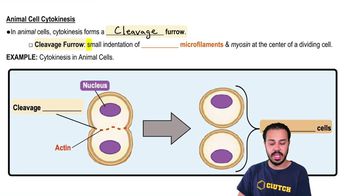Table of contents
- 1. Introduction to Biology2h 42m
- 2. Chemistry3h 40m
- 3. Water1h 26m
- 4. Biomolecules2h 23m
- 5. Cell Components2h 26m
- 6. The Membrane2h 31m
- 7. Energy and Metabolism2h 0m
- 8. Respiration2h 40m
- 9. Photosynthesis2h 49m
- 10. Cell Signaling59m
- 11. Cell Division2h 47m
- 12. Meiosis2h 0m
- 13. Mendelian Genetics4h 44m
- Introduction to Mendel's Experiments7m
- Genotype vs. Phenotype17m
- Punnett Squares13m
- Mendel's Experiments26m
- Mendel's Laws18m
- Monohybrid Crosses19m
- Test Crosses14m
- Dihybrid Crosses20m
- Punnett Square Probability26m
- Incomplete Dominance vs. Codominance20m
- Epistasis7m
- Non-Mendelian Genetics12m
- Pedigrees6m
- Autosomal Inheritance21m
- Sex-Linked Inheritance43m
- X-Inactivation9m
- 14. DNA Synthesis2h 27m
- 15. Gene Expression3h 20m
- 16. Regulation of Expression3h 31m
- Introduction to Regulation of Gene Expression13m
- Prokaryotic Gene Regulation via Operons27m
- The Lac Operon21m
- Glucose's Impact on Lac Operon25m
- The Trp Operon20m
- Review of the Lac Operon & Trp Operon11m
- Introduction to Eukaryotic Gene Regulation9m
- Eukaryotic Chromatin Modifications16m
- Eukaryotic Transcriptional Control22m
- Eukaryotic Post-Transcriptional Regulation28m
- Eukaryotic Post-Translational Regulation13m
- 17. Viruses37m
- 18. Biotechnology2h 58m
- 19. Genomics17m
- 20. Development1h 5m
- 21. Evolution3h 1m
- 22. Evolution of Populations3h 52m
- 23. Speciation1h 37m
- 24. History of Life on Earth2h 6m
- 25. Phylogeny2h 31m
- 26. Prokaryotes4h 59m
- 27. Protists1h 12m
- 28. Plants1h 22m
- 29. Fungi36m
- 30. Overview of Animals34m
- 31. Invertebrates1h 2m
- 32. Vertebrates50m
- 33. Plant Anatomy1h 3m
- 34. Vascular Plant Transport1h 2m
- 35. Soil37m
- 36. Plant Reproduction47m
- 37. Plant Sensation and Response1h 9m
- 38. Animal Form and Function1h 19m
- 39. Digestive System1h 10m
- 40. Circulatory System1h 57m
- 41. Immune System1h 12m
- 42. Osmoregulation and Excretion50m
- 43. Endocrine System1h 4m
- 44. Animal Reproduction1h 2m
- 45. Nervous System1h 55m
- 46. Sensory Systems46m
- 47. Muscle Systems23m
- 48. Ecology3h 11m
- Introduction to Ecology20m
- Biogeography14m
- Earth's Climate Patterns50m
- Introduction to Terrestrial Biomes10m
- Terrestrial Biomes: Near Equator13m
- Terrestrial Biomes: Temperate Regions10m
- Terrestrial Biomes: Northern Regions15m
- Introduction to Aquatic Biomes27m
- Freshwater Aquatic Biomes14m
- Marine Aquatic Biomes13m
- 49. Animal Behavior28m
- 50. Population Ecology3h 41m
- Introduction to Population Ecology28m
- Population Sampling Methods23m
- Life History12m
- Population Demography17m
- Factors Limiting Population Growth14m
- Introduction to Population Growth Models22m
- Linear Population Growth6m
- Exponential Population Growth29m
- Logistic Population Growth32m
- r/K Selection10m
- The Human Population22m
- 51. Community Ecology2h 46m
- Introduction to Community Ecology2m
- Introduction to Community Interactions9m
- Community Interactions: Competition (-/-)38m
- Community Interactions: Exploitation (+/-)23m
- Community Interactions: Mutualism (+/+) & Commensalism (+/0)9m
- Community Structure35m
- Community Dynamics26m
- Geographic Impact on Communities21m
- 52. Ecosystems2h 36m
- 53. Conservation Biology24m
11. Cell Division
Cytokinesis
Problem 8`
Textbook Question
The drug cytochalasin B blocks the function of actin. Which of the following aspects of the animal cell cycle would be most disrupted by cytochalasin B?
a. Spindle formation
b. Spindle attachment to kinetochores
c. Cell elongation during anaphase
d. Cleavage furrow formation and cytokinesis
 Verified step by step guidance
Verified step by step guidance1
Understand the role of actin in the cell cycle. Actin is a protein that forms microfilaments, which are part of the cytoskeleton and play a crucial role in various cellular processes, including cytokinesis.
Identify the process in the cell cycle that directly involves actin. During cytokinesis, actin filaments form a contractile ring at the site of the cleavage furrow, which helps in dividing the cell into two daughter cells.
Evaluate each option in the context of actin's function: a) Spindle formation primarily involves microtubules, not actin. b) Spindle attachment to kinetochores is also related to microtubules. c) Cell elongation during anaphase is driven by microtubules. d) Cleavage furrow formation and cytokinesis directly involve actin filaments.
Recognize that cytochalasin B disrupts actin function, which would most affect processes that rely on actin, such as the formation of the cleavage furrow during cytokinesis.
Conclude that the aspect of the animal cell cycle most disrupted by cytochalasin B is cleavage furrow formation and cytokinesis, as this process is dependent on actin filaments.
 Verified video answer for a similar problem:
Verified video answer for a similar problem:This video solution was recommended by our tutors as helpful for the problem above
Video duration:
46sPlay a video:
Was this helpful?
Key Concepts
Here are the essential concepts you must grasp in order to answer the question correctly.
Actin Function in Cells
Actin is a crucial protein that forms microfilaments, part of the cytoskeleton in eukaryotic cells. It plays a significant role in maintaining cell shape, enabling cell movement, and facilitating cell division, particularly during cytokinesis. Actin filaments are essential for forming the contractile ring that leads to the cleavage furrow, which is vital for the physical separation of dividing cells.
Recommended video:
Guided course

Cell Junctions
Cytokinesis in Animal Cells
Cytokinesis is the process during cell division where the cytoplasm of a single eukaryotic cell is divided to form two daughter cells. In animal cells, this involves the formation of a cleavage furrow, which is driven by a contractile ring composed of actin and myosin filaments. The contractile ring constricts the cell membrane, leading to the physical separation of the two new cells.
Recommended video:
Guided course

Animal Cell Cytokinesis
Role of Actin in Cleavage Furrow Formation
The cleavage furrow is an indentation that begins the process of cytokinesis in animal cells. Actin filaments, along with myosin, form a contractile ring beneath the plasma membrane at the site of the furrow. This ring contracts, pulling the membrane inward and eventually pinching the cell into two separate entities. Disruption of actin function, such as by cytochalasin B, would impede this process, preventing successful cytokinesis.
Recommended video:
Guided course

Animal Cell Cytokinesis
Related Videos
Related Practice












